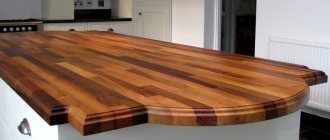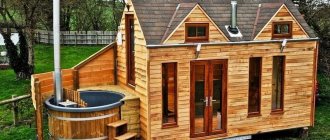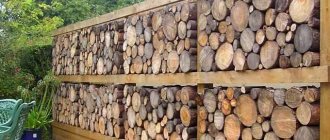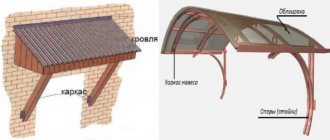The most important element of a kitchen set is the countertop. During its entire service life, it is exposed to various negative factors in the domestic environment, since all food preparation work is performed on it (kneading dough, cutting meat, fish, vegetables, etc.). Therefore, the countertop must have maximum strength and resistance to mechanical damage.
A kitchen countertop made of porcelain stoneware is an excellent solution for the design of a modern kitchen.
Porcelain stoneware is considered one of the best materials used to make this work surface. In terms of its performance properties, artificial stone is no different from natural stone, but has a more affordable price.
The biggest advantage of porcelain stoneware is its affordable price.
Do-it-yourself porcelain stoneware countertop: how to make it from tiles
The canvas can be made from thick or thin, large or small tiles. Although the material is intended for flooring, it is also suitable for finishing tables, aprons, and window sills. By design, these are stacked panels with minimal seams. The end is finished with tiles (other materials can be used).
Materials, tools
If you choose 10x10 cm or 15x15 cm tiles, you can lay them yourself. Small elements are not heavy; they are laid on a surface made of wood, plastic, or metal. Before purchasing, you need to calculate the number of tiles so that there is enough for the end. A margin of up to 15% is also required for damage due to natural losses during installation.
Installation requires:
- Chipboard (22-38 mm)/plywood (10-15 mm);
- transparent soil that repels water;
- PVA (wood glue);
- rubber grout and spatula;
- sealant (silicone);
- drill;
- electric jigsaw;
- notched spatula;
- self-tapping screws (38 mm).
It is important to understand: in order to make a kitchen countertop from porcelain stoneware with your own hands, you need to buy or rent a special tile cutter.
Mounting options
There are several ways to install the countertop:
- Floor-mounted mounting. The tabletop can be installed on a cabinet or legs. This method is the most reliable and sustainable.
- Suspended design. The device is attached to the wall using pre-installed brackets. Such a countertop made of tiles in a bathroom looks modern and stylish, creating a light effect.
Advantages and disadvantages of porcelain stoneware countertops for the kitchen
The raw materials for the production of porcelain tiles are environmentally friendly. The finished material does not release toxic substances into the room and does not contribute to the proliferation of harmful microorganisms. Hardness is sufficient for surfaces of any size. A large selection of colors allows you to choose tiles to suit any design. Small tiles can be laid yourself.
Other advantages are no less important:
- resistance to household chemicals and mechanical damage;
- thermal stability (you don’t need to use a stand for hot dishes);
- resistance to high humidity;
- practicality, easy care;
- maintainability;
- durability;
- attractive look.
The price of porcelain stoneware is 5 times lower than the cost of natural stone. Some consider the disadvantage to be the increase in final cost when using products from foreign manufacturers.
Other disadvantages:
- the installation process is relatively labor-intensive;
- seams are regularly updated;
- in the absence of regular wiping, the shine of the surface is lost;
- Do not use cleaning agents containing acids.
- Another disadvantage of porcelain stoneware is its fragility. The fact is that porcelain stoneware exhibits excellent resistance to impacts and other damage only after laying on the surface. And porcelain stoneware itself can easily break, especially during transportation.
Porcelain tiles can crack even during transportation
If it is necessary to replace such a tabletop, it is difficult to dismantle it.
Advantages
The main advantages of countertops made of porcelain tiles include the following factors.
- Attractive appearance.
- Resistant to chips and cracks, as well as chemical influences (oils, paints, detergents).
- High heat resistance, allowing you to install the work surface next to the stove.
- No harmful additives or dyes in the material.
- Durability.
- Easy to care for.
The biggest advantage of porcelain stoneware is its durability and resistance to damage.
Note! Artificial stone is presented in a wide color palette, so the countertop can be matched to any kitchen interior.
See also: Kitchen stone finishing
Choosing porcelain tiles
Porcelain tiles for covering kitchen surfaces come in various sizes.
Porcelain stoneware surfaces are:
- processed, unprocessed;
- glazed, polished, semi-matte, matte;
- anti-slip;
- imitating other materials.
When choosing, it is important to consider that a glossy surface is not practical. Imitations of other materials are porous, requiring the use of special cleaning agents.
How to glue edges to furniture?
To glue edges on furniture, hot melt adhesives on various bases are used: ethylene vinyl acetate (EVA), polyurethane (PUR), polypropylene (PO).
- EVA adhesives are very popular in the woodworking industry. ...
- Polyurethane analogues provide additional strength.
Interesting materials:
How to turn off a car on an A93? How to turn off a car automatically? How to order two cars in Uber? How to burn an audio CD into a car? How to burn an mp3 disc for a car? How to burn an mp3 disc to a car? How to fill out a declaration for the sale of a car? How to start a Haier washing machine? How to register a car with the traffic police through government services? How to insure a car through Erip?
Large size porcelain tiles for countertops
The large format is quickly installed, there are few seams, and the amount of waste is minimal. This material is also used for lining the apron, barbecue area and kitchen table in the country.
Self-assembly is made difficult by high-precision cutting, which requires a grinder with diamond blades. If you want to get a cladding that will look expensive, large format is not used.
There are two types of porcelain tiles. These are unpolished and polished porcelain tiles. Both the first and second types have the same scope of application, but they differ in appearance and cost. The price of polished porcelain tiles is several times higher than the price of unpolished porcelain tiles.
Wood-effect porcelain stoneware countertop
An Internet user described how he made a kitchen countertop from plywood, chipboard and wood-look porcelain stoneware. The base was created from 1.5 cm plywood, a chipboard was used as a support. A beam is fixed to the wall; porcelain tiles were sawed for edging.
Laying diagram of porcelain tiles for countertopsWood-effect tiles are popular thanks to the fashion for natural materials. They are often used by professional designers. The quality of the material is high, the appearance is aesthetically attractive. To make the coating last longer, it is recommended to buy AA class material.
Tabletop made from remnants of porcelain tiles
During large-scale repairs, a lot of materials remain, since they are calculated with a reserve. If there is porcelain tile left, it can be used to finish the kitchen table. The frame is assembled from slats, the chipboard base is primed. The same glue used for flooring is suitable for installing porcelain tiles.
Porcelain stoneware countertops 60×60 cm
Such elements are classified as large. OSB is used for the base. If the thickness is not enough, pieces of chipboard are screwed in with self-tapping screws. The tiles are glued with liquid nails. Aluminum end strips. This is a soft material that is not difficult to cut with a hacksaw. The edges are smoothed with a grinding stone to prevent scratching. A plank made of wood is also suitable.
Porcelain stoneware countertop 30×30 cm
If there are no leftovers, the material is often selected based on price. In such situations, 30-30 cm planks are more profitable. They are laid using the same technology as the overall ones.
Mosaic and small-format porcelain tile countertops
For the base, plywood or plasterboard is used; an old tabletop that requires restoration is also suitable. If there is concrete left after the repair, the base can be made from it. However, please note that it takes 28 days to dry.
Before installation, a preliminary layout is made, mosaic elements or small porcelain tiles are numbered. The pattern must be transferred to the base, the tiles are placed on the surface, and glue intended for the base material is used for gluing. After a day, the crosses are removed and the joints are grouted.
Grouting joints
No matter how hard you try, you will still get a thin line at the junction of the tiles, so purchase grout in advance. It is better to buy materials based on epoxy resin: they have increased resistance to all reagents, fats, oils and temperature changes.
You can buy them at any hardware store, it’s better to be guided by the cost. The price for quality products will be a little higher, but they will last longer.
Most often, products are sold in the form of two components, which are mixed together in a separate container and are immediately ready for application.
Grouting tips:
- Use small rubber spatulas to thoroughly coat the joint without damaging the tile.
- To simplify the process of cleaning the surface of porcelain tiles from grout, you can use masking tape. It glues easily and does not leave streaks: glue it along the entire length of the line you are going to process.
- It is better to remove dried grout after a day.
Making your own porcelain stoneware table: installation rules
Ready-made tables are relatively expensive. If you want to get a practical, comfortable, presentable piece of furniture, you can make kitchen countertops from porcelain stoneware yourself if you have minimal skills in working with tools and the right choice of materials. The finished table will be exclusive, no one else will have anything like it. But it is better to choose smaller porcelain stoneware tiles; they will be easier to lay and trim if necessary.
Preparing the base
One layer of chipboard or two layers of plywood is laid on plastic and wooden surfaces. When calculating the dimensions, it is taken into account that the canvas extends 1 cm from the front side and 2 cm beyond the side edges. Accuracy requires calculations in the locations of the sink and hob. A jigsaw is used to cut holes. Before laying the tiles, the surface is treated with a waterproofing compound and dried.
When using plywood, the first sheet is attached to the cabinets with self-tapping screws. The caps are completely immersed and treated with putty. To glue the second sheet, moisture-resistant PVA or wood glue is required. The edges are fastened with self-tapping screws. If the length of the sheets is not enough, they are fastened so that the joints do not coincide. A sealant is required to process the joints.
The chipboard is attached with self-tapping screws, and the surface is treated with a primer that repels water.
If the base is metal, it must be degreased with a nitro solvent and treated with sandpaper. Then two layers of primer are applied and a steel reinforcing mesh is secured.
End cladding
For the ends, cut tiles, porcelain stoneware borders, and furniture profiles are used. To prevent the cladding from falling during the drying process, it is advisable to secure it with tape, which can then be easily removed.
Laying and grouting
Before gluing, it is advisable to lay out the tiles in such a way as to more accurately determine the location.
Sequencing:
- the layout starts from the cutout for the sink or corner;
- epoxy glue is applied to the base with a notched trowel (with little experience, you should not dilute a lot), the tiles are lightly pressed against the base;
- seam width 1-2 mm;
- rows containing trimmed elements are located against the wall;
- The quality of installation is controlled by the level.
Residues of glue are removed immediately, grouting is carried out after 1-3 days (depending on the drying time of the glue from a particular manufacturer). The material must be made from epoxy. A rubber spatula is required for application; excess is removed immediately. After complete drying, the joints are treated 2 times with soil that repels water. To process the seam at the junction with the wall, silicone sealant is used.
When installing the hob, be sure to use a sealing tape. It is not enough to cover the cutout. It should be without cuts, with neat bends at the corners. For fastening, special plates and screws are used. After installing the panel, the joint is treated with silicone sealant. When installing a sink, the same technology is used.
Sink on the countertop in the bathroom: which bowl to choose
The standard installation method is an under-counter sink. It’s convenient, familiar, and sometimes seems like the only possible option. But supporters of original bathroom design are increasingly paying attention to sinks that are placed above the countertop. Although it would be more appropriate to call them “bowls”.
They are made from the same materials as the mortise versions; we can only add that such models are also made of glass and metal. The shape is usually round, sometimes oval. Exclusive options can be made in the form of a petal, an irregular triangle, etc.
A sink mounted on a countertop makes the design lighter and more interesting.
Is this method of placing a washbasin convenient? According to users, this depends on the shape and depth of the bowl, its level and the spout of the mixer. Same features as built-in models. Therefore, the conclusion suggests itself that this installation method only affects the interior design.
A sink on a countertop, in particular a glass one, makes the design lighter and more interesting. It should be noted that overhead bowls, especially original shapes, are not always convenient. Splashes of water do not flow down the flat walls, but hit the vertical side surfaces. The small size of the sinks can be organic in the overall design, but it is sometimes impossible to wash your face without splashes flying around.
Overhead bowls are not always easy to use and maintain
Another difficulty arises in the maintenance process: it is necessary to constantly clean not only the internal, but also the external surface.
Helpful advice! Even the most original bowl will lose its charm if there are traces of drops and detergents on it. It is impossible to clean the surface after every hand washing. It is better to sacrifice the decorativeness of the product and purchase an option where the dirt will be less noticeable.
Stylish ideas from designers: photos
The kitchen countertop determines the style of the room. When choosing, it is advisable to take into account some of the designers' recommendations. They advise using porcelain stoneware in small kitchens, decorated in a minimalist style. When choosing a material similar to wood, the kitchen will become more comfortable. For any design, you can buy polished, glossy material.
Some ideas can be borrowed from the photos below.
How to choose the style of the room?
The tabletop cannot be called a “capricious lady”. The surface of the table can effectively emphasize the sophistication of the kitchen set or “dissolve” against its background. It seems that the simplest solution would be to choose a countertop that matches the color of the facades. But it's not entirely simple. It is not always possible to find materials of the same shades .
There are no difficulties when installing monochrome furniture. But black will be sad, and white will be impractical. In this case, the set will visually look large and “monolithic”. To destroy these feelings, you will need bright decorative elements.
The choice of contrasting materials should be thoughtful and determined by the style of the room. A high-tech or minimalist interior can be decorated in black and white. A soft rustic mood will be better emphasized by a range of similar shades (sand/brown, white/blue, light green/green).
To create a harmonious environment, it is advisable to “link” the tiled countertop with other surfaces in the interior. A win-win way is to have the same finish on the table and window sill.
Rustic style
An excellent design move is to decorate the apron and tabletop with the same material. This duet in the kitchen can become one compositional solution.
The combination of floor finishing and work surface made of the same material looks original. Moreover, manufacturers often offer tile collections united by one shade or pattern. A stone union (squares of the same color on the floor and on the table) will give the kitchen a noble look. We must admit that such materials are not cheap.
Decoration with snow-white tiles
Porcelain stoneware countertops for the kitchen reviews
Most reviews about porcelain stoneware tables are positive. Sheet materials hide surface unevenness, but have some disadvantages: they change size with fluctuations in temperature and humidity levels. The problem is solved by installing DSP on plywood.
It is better to order a porcelain stoneware countertop. However, doing such work with your own hands has advantages: the opportunity to take into account your own preferences and make a piece of furniture that will become the pride of the family.
Sunny Mediterranean flavor
A kitchen decorated in a bright mood looks summery and joyful at any time of the year. Natural materials (wood, stone, metal) are used to decorate the kitchen. The range of natural shades (cream-yellow, greenish-sand, white-blue) evokes only positive emotions. The Mediterranean interior can be given a different character:
- in the Italian direction stone dominates. The material is used for finishing literally all surfaces (floor, walls, ceiling). Stone squares are incredibly convenient in everyday life and look very colorful. You can decorate the work surface with textured material. Suitable colors – gray, brown;
Stylish kitchen in dark colors
- The Spanish interior will be decorated with bright azulejo tiles. This unique material will refresh a wall near the work area or an apron in an unusual way. To prevent the kitchen from looking provocative or colorful, choose a plain, dark-colored material for the tabletop decor;
- Greek-style kitchens are characterized by the use of rough-finished wooden surfaces. White plastered/painted walls will highlight the natural grain of the wood. The kitchen decor looks somewhat laconic, but at the same time fresh and light.
When decorating a kitchen in a Mediterranean style, it is not necessary to create the decor in perfect condition.
On the contrary, some irregularities, chips, cracks will emphasize the naturalness of the situation.
Classic style
An excellent option for an Italian-style kitchen: the walls are plastered and painted with matte sand-colored paint. The kitchen apron is lined with decorative rectangular red brick tiles imitating brickwork. The tabletop is decorated with squares of sand-colored porcelain stoneware (to match the walls).
Appliances with chrome surfaces will dilute the brown color. The hood is made of the same metal. Light sand-colored kitchen facades will visually make the room lighter and more spacious.
Small square azulejo products will add unusual brightness to a Mediterranean interior with Spanish notes. Each square can be an independent picture or part of a national ornament. In order not to distract attention from the bright decor, single-color tiles are selected for the desktop.
To maintain the glossy shine of the wall surface, choose glazed ceramic squares or shiny porcelain tiles for the table.
When everything is in the same style and in the same color
The ascetic Greek Mediterranean style is distinguished by simple forms. The interior is strictly decorated, monochromatic light shades, combined with wooden elements, give the atmosphere coziness and tranquility . In such a kitchen it is pleasant to welcome guests and chat leisurely. The countertop, lined with square ceramic tiles, is easy to care for.











